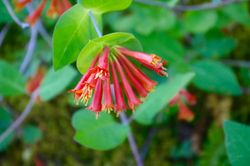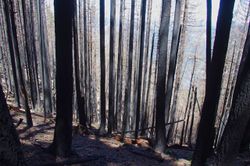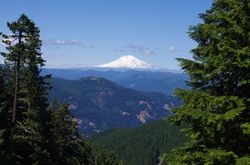Difference between revisions of "Mount Defiance-Starvation Ridge Loop Hike"
From Oregon Hikers Field Guide
(Add pictures) |
|||
| Line 14: | Line 14: | ||
[[Image:MtHoodFromMtDefiance.jpg|thumb|400px|View of Mount Hood from the summit of Mount Defiance ''(Jeff Statt)'']] | [[Image:MtHoodFromMtDefiance.jpg|thumb|400px|View of Mount Hood from the summit of Mount Defiance ''(Jeff Statt)'']] | ||
| + | [[Image:Orange honeysuckle (Lonicera ciliosa), Mt. Defiance Trail.jpg|thumb|250px|Orange honeysuckle ''(Lonicera ciliosa)'', Mt. Defiance Trail ''(bobcat)'']] | ||
[[Image:Slope of blackened trunks, Mt. Defiance Trail.jpg|thumb|250px|Slope of blackened trunks from the 2017 Eagle Creek Fire, Mt. Defiance Trail ''(bobcat)'']] | [[Image:Slope of blackened trunks, Mt. Defiance Trail.jpg|thumb|250px|Slope of blackened trunks from the 2017 Eagle Creek Fire, Mt. Defiance Trail ''(bobcat)'']] | ||
| − | [[Image: | + | [[Image:Andesite bluffs, Mt. Defiance Trail.jpg|thumb|250px|Andesite bluffs, Mt. Defiance Trail ''(bobcat)'']] |
| − | [[Image: | + | [[Image:Bear Lake from the Mt. Defiance Trail.jpg|thumb|250px|Bear Lake from the Mt. Defiance Trail ''(bobcat)'']] |
| + | [[Image:Mt. Adams from the talus slope, Starvation Ridge Trail.jpg|thumb|250px|Mt. Adams from the upper talus slope, Starvation Ridge Trail ''(bobcat)'']] | ||
| + | [[Image:View down to Lindsey Pond, Starvation Ridge Trail.jpg|thumb|250px|View down to Lindsey Pond, Starvation Ridge Trail ''(bobcat)'']] | ||
| + | [[Image:Mock orange (Philadelphus lewisii), Starvation Ridge Trail.jpg|thumb|250px|Mock orange ''(Philadelphus lewisii)'', Starvation Ridge Trail ''(bobcat)'']] | ||
[[Image:DefianceStarvationLoopMap.jpeg|thumb|400px|Crowd sourced GPS "average" ''(aiwetir)'']] | [[Image:DefianceStarvationLoopMap.jpeg|thumb|400px|Crowd sourced GPS "average" ''(aiwetir)'']] | ||
Revision as of 01:46, 15 June 2018
- Start point: Starvation Creek Trailhead
- End point: Mount Defiance
- Trail Log: Trail Log
- Hike Type: Loop
- Distance: 12.8 miles
- Elevation gain: 4970 feet
- High point: 4,959 feet
- Difficulty: Difficult
- Seasons: Mid-May through October
- Family Friendly: No
- Backpackable: Yes
- Crowded: Yes, on weekends
Contents |
Hike Description
At 4,959 feet, Mount Defiance is the highest point in the the Columbia River Gorge. This loop hike, with its almost 5,000-foot elevation gain, has become a popular training course for mountaineers and trail runners. It's also considered the toughest hiking challenge in the area. You begin at Starvation Creek State Park along Interstate 84 on the Columbia River. From there, it's a relentless ascent on the Mt. Defiance Trail, much of which was scorched in the September 2017 Eagle Creek Fire. Take the Mt. Defiance Trail, rather than the Cutoff Trail, as you approach the summit to get more views of Cascade and Gorge peaks from an expansive talus slope. You way down will be via the Mount Defiance Cutoff Trail to the Mitchell Point Trail and east to Warren Lake. Below the lake, you'll intersect with the Starvation Ridge Trail, which descends rather ruthlessly down the spine of a narrow ridge. Splendid views open up after you exit the Mark O. Hatfield Wilderness and reach the powerline corridor on the steep grassy slopes above the river. Give yourself plenty of time, and start early in the day; also, wait for good weather so you can enjoy the views along the way.
You'll start by heading westward on the Historic Columbia River Highway State Trail, which runs alongside I-84 from the Starvation Creek Trailhead. Get views to the the twin microdioritic intrusions of Shellrock Mountain and Wind Mountain as well as Dog Mountain right across the river. Enter shady maple woods, and look down to see markers dedicating this restored section of the Historic Columbia River Highway. Then pass the Historic Columbia River Highway-Starvation Ridge Cutoff Trail Junction. In spring, candy flower blooms profusely alongside the paved surface. Reach two-tiered, 220-foot Cabin Creek Falls, where a huge fallen basalt boulder creates an almost hidden amphitheater. The waterfall sprays directly into this hidden area. The Historic Columbia River Highway heads back out to the freeway under a Douglas-fir/big-leaf maple canopy.
At an open area, arrive at the Historic Columbia River Highway-Mount Defiance Trail Junction. Go left on a paved trail that passes through a circular picnic area. The Mount Defiance Trail picks up its normal tread here, and 95-foot Hole in the Wall Falls can be viewed from the picnic circle. This waterfall is an unusual manmade affair. Highway crews drilled a tunnel through the rock and diverted Warren Creek here in 1938 to resolve issues with the creek undermining the highway. The water emerges from a lengthy tunnel and immediately falls, creating the waterfall. From here, you'll take the footbridge below Hole in the Wall Falls. The trail begins a modest climb, gaining about 140 feet in elevation. You'll reach the powerline corridor, where there's another trail junction, this time with the Starvation Ridge Trail. Honeysuckle, snowberry, stonecrop, and white spiraea bloom here in the spring. Stay to the right.
Soon the trail reaches Wonder Creek and the lower tier of Lancaster Falls. The waterfall seems small at first glance, but from the right angle, the tall 250-foot upper tier is visible through the trees (The best place to get an accurate impression of Lancaster Falls is by traveling the freeway westbound and pulling off at the weigh station west of the Starvation Creek Trailhead. From late fall to the beginning of spring, before the maples leaf out, you'll get a clear view of the waterfall above. You should only attempt this stop when the weigh station is closed, usually on weekends.). Continue hiking west through the brushy power line corridor, where serviceberry, vine maple, thimbleberry, hazel, snowberry, and poison oak abound. Round a bend, and the rugged profile of Shellrock Mountain hoves into view. You'll also note a grassy abandoned trail bench coming up from the woods below: this is a former track of the Mt. Defiance Trail when it came up from a trailhead near Lindsey Creek. Make two switchbacks up, and before entering the slope forest get good views of Wind Mountain, Dog Mountain, and Cook Hill.
From here, it's up, and we mean "up". The trail begins switchbacking up the side of the Gorge almost immediately. You'll gain over 3,000 feet in elevation over the next three miles! Make five switchbacks up, crossing the expanded (2009) boundary of the Mark O. Hatfield Wilderness (There's no sign to proclaim this, though). At the 6th switchback, you'll encounter the lower reaches of the 2017 Eagle Creek Fire: burn damage, here mainly a ground fire, will accompany you for the next three and a half miles. Use a chopped step to go over a charred log, and make three switchbacks to the rim overlooking Lindsey Creek. Cross an old logging track, and note the green plants that have returned after the fire, including pathfinder, sword fern, wood fern, trailing blackberry, sandwort, thread-leaf phacelia, solomon plume, Oregon grape, and snowberry. At a contorted Douglas-fir, a grassy slope fringed with oaks blooms with balsamroot in mid-spring. Make eleven more switchbacks, crossing the nose of the ridge, and reach a viewpoint to Shellrock Mountain, Wind Mountain, Greenleaf Peak, and Table Mountain. Switchback over to the west side of the ridge, and reach a section of the 2017 burn where there was a crown fire and all the trees were killed. Make three more switchbacks to a gentler grade of the trail in an area less severely burned.
Pass an unscorched vine maple thicket on the left, and head up an old logging track between low ridges of vegetated talus. In this area, the trail served as a firebreak. However, you'll soon wind up into another section of forest that was killed by a crown fire. The ascent deepens again as you rise under a Douglas-fir canopy. Now you're seeing low scorch marks on trees from a slow-burning ground fire. Hike up through a leafy carpet of bear-grass, arnica, and vanilla leaf to reach a wilderness sign at the pre-2009 boundary. You've only about 1,000 feet in elevation to go from here! Soon reach the outer limit of the Eagle Creek Fire in a stunted forest of Douglas-fir, mountain hemlock, and noble fir. A spur to the right leads to a view of andesite bluffs and an expansive talus slope. The trail passes up through huckleberry, Sitka alder, boxwood, and mountain ash to a vista over the Washington side of the Columbia River Gorge and on to Mount Saint Helens, Mount Rainier, and Mount Adams. Make a rocky traverse, getting more views of Mount Adams. Come to the Mount Defiance-Mitchell Point Trail Junction, and go right.
You'll continue up for less than a quarter mile to reach another junction, this one (in 2018) marked with only temporary signs. Make a right here for a slightly longer but more scenic route to the summit of Mount Defiance. Cross a talus slope to get another view of the snow-capped Washington volcanoes. Between the river and Mount Adams, you can make out the top of Dog Mountain, Augspurger Mountain, Big Huckleberry Mountain, and the spine of Indian Heaven. Wind up in a shady montane forest, and begin a traverse of a lengthy talus slope. Look down on Bear Lake and across to Green Point Mountain. Mount Saint Helens can be seen to the northwest. Reach the Mount Defiance-Mount Defiance Cutoff Trail South Junction, with its broken sign down on the ground, and go left.
Hike up the talus slope, getting a magnificent view of Mount Hood to the south. Clumps of common juniper and Cardwell's penstemon have found purchase on the jumbled andesite. The trail reenters the woods and arrives at the summit with its radio tower and fenced compound. To your right, you can find a perch above a slope of large boulders. Gawk at the expansive vista towards Mount Hood and east to the Hood River Valley for as long as you like.
Now for the return section of the loop. Hike around the communication compound, and find the Mt. Defiance Trail leading down into the trees. Reach the maintenance road, and resume the trail at a High Voltage sign. Continue descending through a huckleberry understory under a canopy of mountain hemlock, noble fir, and silver fir. Cross the maintenance road again, pass a wilderness sign, and keep dropping on a rocky tread. When you reach the Mount Defiance-Mount Defiance Cutoff Trail North Junction, stay left and descend the quarter mile to the well-marked Mount Defiance-Mitchell Point Trail Junction in an area of lodgepole pines.
Make a right here on the Mitchell Point Trail for Warren Lake. The trail offers glimpses of Mount Saint Helens, Mount Rainier, and Mount Adams as it traverses through the trees. Then drop steeply down a talus slope where the trail is marked by several large cairns. Before you reenter the trees, you can go to the right across the talus to get a view down to Warren Lake. Descend steeply again to reach the bottom of the talus with its skirt of vine maple. The trail enters a shady Douglas-fir forest and passes above the shore of Warren Lake with its several campsites. Then rise through a lush understory of huckleberry, arnica, and Oregon grape to pass another campsite. Make a level traverse through vanilla leaf, bunchberry, and arnica to exit the wilderness and reach the Mitchell Point-Warren Lake Trail Junction. To your right, you can see the bollards at the old trailhead for Warren Lake; the new trailhead is about 1/4 mile south of the junction.
Keep left here, and rise gently, noting a selectively logged forest to your right. Hiking above the rim of the bowl that feeds Warren Creek, you'll get a view up to the summit of Mount Defiance. The trail now begins its relentless drop to river level. Pass through a vine maple thicket, and see the end of a logging road down to your right. Taller Douglas-fir firs shade the trail here, but soon you'll wind down into a partial clearcut that is fast regenerating with young Douglas-firs and noble firs. Bear-grass blooms here in late spring. Get a view of Mount Adams and the summit of Mount Rainier before arriving at the signposted Starvation Ridge-Mitchell Point Trail Junction. The western vestige of the Mt. Mitchell Trail disappears into the young conifers, but soon winds up at an abandoned logging road which connects with the roads and trails at the Post Canyon Mountain Bike Trail system.
Keeping straight, you're now on the Starvation Ridge Trail. Descend through a vine maple thicket to a steep talus slope that offers an outstanding view to Mount Adams. Here you will be reentering the Mark O. Hatfield Wilderness. The trail drops steeply under large Douglas-firs above the headwaters bowl of Starvation Creek. There will be eight switchbacks before a long traverse where you'll pass below a "headless" Douglas-fir whose main branch has taken up the role of new "head" or trunk. Get another view of Mount Adams, and keep descending through a lush thicket above another talus bowl. You'll note paintbrush, alumroot, and heliotrope blooming here in late spring. At the next talus slope, pikas may be squeaking in alarm. Wind down a narrow ridge crest; a viewpoint on the left offers a vista towards the upper meadows of Dog Mountain, [[Wind Mountain], and Mount Saint Helens. Thread through some venerable Douglas-firs as you drop steeply down the ridge. In this section, you'll hit short level stretches leading to more steep drops on the trail. Pass above a steep oak meadow with lupine, blue field gilia, and taper-tip onions as springtime blooms. At this point, you're at about the 1,200 foot level, the poison oak begins, and you're exiting the Mark O. Hatfield Wilderness.
Hike gently up through some overhanging poison oak under Douglas-firs. Pass through a wood of stunted oaks, and then descend to a powerline pylon with an active osprey nest. Dog Mountain is broadside on, and you can see west to the twin humps of Shellrock Mountain and Wind Mountain. Make three switchbacks down a grassy slope with yarrow, balsam root, gilia, wild onion, and lupine. Switchback in Douglas-fir/big-leaf maple forest, and then hike under a pylon in another steep meadow. Make three more switchbacks before you reenter the shady woods. Switchback, emerge into the sunshine again, and descend five switchbacks in forest and meadow to a viewpoint partially blocked by encroaching shrubbery. Two more switchbacks pass you through another oak meadow before you arrive at the Starvation Ridge-Starvation Ridge Cutoff Trail Junction.
Go right to descend the Starvation Ridge Cutoff Trail #414B down the nose of a ridge in an oak savanna. Drop steeply, and switchback through a thimbleberry thicket to cross a dangerous slide. A set of short switchbacks takes you to the Historic Columbia River Highway-Starvation Ridge Cutoff Trail Junction, whence you can go right to return to the trailhead.
Maps
- Maps: Hike Finder
- Mount Defiance Trail #413 (USFS)
- Mitchell Point Trail #417 (USFS)
- Starvation Ridge Trail #414 (USFS)
- Green Trails Maps: Hood River, OR #430
- Green Trails Maps: Columbia River Gorge - West #428S
- Geo-Graphics: Trails of the Columbia Gorge
- U.S. Department of Agriculture, Forest Service/Bureau of Land Management: Columbia River Gorge
- U.S. Department of Agriculture, Forest Service: Zigzag Ranger District
- U.S. Department of Agriculture, Forest Service: Mt. Hood National Forest
- National Geographic Trails Illustrated Map: Columbia River Gorge National Scenic Area
Regulations or restrictions, etc
- Restrooms and picnic area at trailhead
Trip Reports
- Search Trip Reports for Mount Defiance-Starvation Ridge Loop
- Ma bear + 6 cubs on toasted Defiance/Starvation loop
- GoalTechHikes Mt Defiance - Eagle Creek Burn - 052018
- Mt Defiance Trail May 20, 2018
Related Discussions / Q&A
- Search Trail Q&A for Mount Defiance-Starvation Ridge Loop
Guidebooks that cover this hike
- Day Hikes in the Columbia Gorge by Don J. Scarmuzzi
- 100 Hikes in Northwest Oregon & Southwest Washington by William L. Sullivan
- Hiking the Columbia River Gorge by Russ Schneider; revised by Jim Yuskavitch
- Day Hiking: Columbia River Gorge by Craig Romano
- Take a Hike: Portland by Barbara I. Bond
- 100 Classic Hikes in Oregon by Douglas Lorain
- Afoot & Afield: Portland/Vancouver by Douglas Lorain
- 70 Virtual Hikes of the Columbia River Gorge by Northwest Hiker
- Columbia Gorge Hikes: 42 Scenic Hikes by Don & Roberta Lowe
- Oregon Hiking by Sean Patrick Hill
- Pacific Northwest Hiking by Scott Leonard & Sean Patrick Hill
More Links
- Mt. Defiance Trail (#413) (USFS)
- Mitchell Point Trail #417 (USFS)
- Starvation Ridge (USFS)
- Mount Defiance (Oregon) (Washington Trails Association)
- Mount Defiance Hike (Outdoor Project)
- Mount Defiance (Friends of the Columbia Gorge)
- Mount Defiance (Portland Monthly)
- Mount Defiance–Starvation Ridge Loop (The Mountaineers)
- Hiking Mount Defiance in Oregon (Adventure Strong)
- Mount Defiance: Oregon's most difficult day hike, Oregon (Matt Cook)
- Mount Defiance (Summit Post)
- "More trails impacted by Eagle Creek fire now back open" (KATU)
- "Mount Defiance, 7 more trails reopen in Columbia River Gorge" (KGW8)
Contributors
- Stevefromdodge (creator)
- Fallsfreak
- romann










